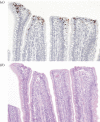Is low pathogenic avian influenza virus virulent for wild waterbirds?
- PMID: 23740783
- PMCID: PMC3774239
- DOI: 10.1098/rspb.2013.0990
Is low pathogenic avian influenza virus virulent for wild waterbirds?
Abstract
Although low pathogenic avian influenza virus (LPAIV) is traditionally considered to have adapted to its wild waterbird host to become avirulent, recent studies have suggested that LPAIV infection might after all have clinical effects. Therefore, I reviewed the literature on LPAIV infections in wild waterbirds. The virulence of LPAIV was assessed in 17 studies on experimental infections and nine studies on natural infections. Reported evidence for virulence were reductions in return rate, feeding rate, body weight, long-range movement and reproductive success, as well as pathological changes in infected organs. However, major caveats in studies of experimental infections were unnatural route of LPAIV inoculation, animal husbandry not simulating natural stressors and low sensitivity of clinical assessment. Major caveats in studies of natural infections were incomplete measurement of LPAIV infection burden, quasi-experimental design and potential misclassification of birds. After taking these caveats into account, the only remaining evidence for virulence was that presence and intensity of LPAIV infection were negatively correlated with body weight. Based on this correlation, together with the demonstrated LPAIV tropism for the intestinal tract, I hypothesize that LPAIV reduces digestive tract function, and suggest how future studies could be directed to test this hypothesis.
Keywords: digestive tract function; experimental design; influenza virus; trade-off model; virulence; waterbirds.
Figures

References
-
- Olsen B, Munster VJ, Wallensten A, Waldenstrom J, Osterhaus AD, Fouchier RA. 2006. Global patterns of influenza A virus in wild birds. Science 312, 384–388.10.1126/science.1122438 (doi:10.1126/science.1122438) - DOI - DOI - PubMed
-
- Reperant LA, Rimmelzwaan GF, Kuiken T. 2009. Avian influenza viruses in mammals. Rev. Sci. Tech. 28, 137–159. - PubMed
-
- Ebert D, Bull JJ. 2003. Challenging the trade-off model for the evolution of virulence: is virulence management feasible? Trends Microbiol. 11, 15–20.10.1016/S0966-842X(02)00003-3 (doi:10.1016/S0966-842X(02)00003-3) - DOI - DOI - PubMed
-
- Swayne DE, Pantin-Jackwood M. 2006. Pathogenicity of avian influenza viruses in poultry. Dev. Biol. (Basel) 124, 61–67. - PubMed
-
- Tscherne DM, Garcia-Sastre A. 2011. Virulence determinants of pandemic influenza viruses. J. Clin. Invest. 121, 6–13.10.1172/JCI44947 (doi:10.1172/JCI44947) - DOI - DOI - PMC - PubMed
Publication types
MeSH terms
LinkOut - more resources
Full Text Sources
Other Literature Sources
Medical
